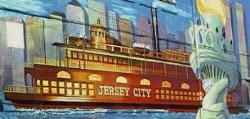 |  |  |
|
| ||
 |  |  |
 |  |  |
|
| ||
 |  |  |

 |
 |

Originally published in 1939
Some of this information may no longer be current and in that case is presented for historical interest only.
Edited by GET NJ, COPYRIGHT 2002
Ship Bottom-Manahawkin-Junction with State 40; State S40.
State S40 runs northwest across Manahawkin Bay from picturesque fish-
ing scenes on Long Beach Island to the sandy mainland. It passes through
the almost flat pine barrens where a small population makes a bare living
from berries, moss, and other swamp products. The western section of the
highway penetrates the State's largest reservation, Lebanon State Forest.
Superficially, State S40 is an uninteresting highway, designed only for
speed. The road offers rare opportunities, however, to any motorist with a
feeling for swamp life akin to that of Thoreau, who preferred swamps to
fine gardens. "Hope and the future for me are not in lawns and cultivated
fields, not in towns and cities, but in the impervious and quaking
swamps," he wrote. "My spirits infallibly rise in proportion to the out-
ward dreariness. Give me the ocean, the desert, or the wilderness! . . . I
enter a swamp as a sacred place, – a sanctum sanctorum. There is the
strength, the marrow of Nature."
It is easy to find a good swamp on the mainland between Manahawkin
and the junction with State 40. The motorist should watch for a sandy side
road near any small stream and turn off for l00 yards or so. Shoes and
stockings should be left in the car, and then there is nothing to do except
wade in. A typical list of discoveries in one hour's exploration in mid-
summer is:
Ship Bottom's odd name is the center of controversy of date and detail
rather than event. One tradition is that in 1817 Capt. Stephen Willits
during a storm came upon a ship aground, bottom up. His men heard tapping inside and chopped a hole with an axe. Out stepped a beautiful
young girl, whom they carried to shore, where she thanked them in a
strange tongue, sank to her knees, and drew the sign of the cross on the
sand. She was sent to New York and never heard of again.
The second version, dated 1846, duplicates the story of the capsized
ship, the tapping, and the appearance of the beautiful young girl. Less
adventurous, however, this maiden remained in the village, was properly
wed, and ultimately became the ancestor of a Sandy Hook pilot.
At Ship Bottom is one of the six life-saving stations that guard this
perilous coast. The wreck of the Powhatan in 1854 with a loss of 354
lives led to formation of a voluntary life-saving crew. One of the founders
was Dr. William A. Newell, known as the father of the U. S. Life Saving Service, who had already obtained a Federal appropriation for this
purpose (see MANASQUAN, Tour 36). On April 4, 1933, the Akron,
U. S. Navy dirigible, was destroyed in a storm off this coast with the loss
of 73 lives.
At Ship Bottom are the junctions with the unnumbered Long Beach
Island roads (see Tour 35A and Tour 35B).
At 0.6 m. a drawbridge crosses the channel of the Inland Waterway.
Cedar stakes with a cross and triangle indicate the main channel. Stakes
with discs and diamonds lead into side channels.
This short drawbridge leads to CEDAR BONNET ISLAND, a collection of tiny fishing islands whose shape resembles a sunbonnet. Close to
the channel is a resort known to sportsmen as MOM'S PLACE (L). Skipper
"Mom" traces her ancestry to a queen of the Lenape Indians. With one
hand on the tiller and the other on the till, she keeps order while dispensing Barnegat hospitality and Jersey lightning.
Barnegat skiffs, molded cedar boats of broad beam with lapped strakes
and engine aft, are frequently seen. They are open, for carrying big loads
of fish; light enough to cross shallows in the bay, and sufficiently seaworthy to negotiate dangerous Barnegat Inlet.
Marshlands in the Barnegat Bay area are in the fall a favorite feeding
ground for migratory waterfowl.
At 3.5 m. are PUBLIC HUNTING AND FISHING GROUNDS (R)
bordering the bay, a 1,000-acre tract where food plants are raised to attract
wild game.
MANAHAWKIN, 5.6 m. (25 alt., 825 pop.) (see Tour 18), is at the
junction with US 9 (see Tour 18).
Close to the highway (R) on the northern outskirts is MANAHAWKIN LAKE, made by damming old Mill Creek to flood nearby
cranberry bogs.
State S40 runs in a northwesterly direction through a low and thinly
populated area, well covered with stunted pines. At 5.8 m. the road turns
slightly L. for its passage in a straight line for the next 17 miles to the
northwest.
At 13.2 m., on a wooded ridge, is the junction with a dirt road.
Left on this road to CEDAR BRIDGE FIRE LOOKOUT, 0.8 m. (open), a 60-foot
tower with men on 24-hour duty. From the observation platform is a sweeping
view of the forest.
CEDAR BRIDGE, 1.2 m. (120 alt.), is a primitive settlement on a low hill
where forgotten Jerseymen whose ancestors were Colonial settlers struggle for a living with poor soil and collect sphagnum moss for florists. The old CEDAR BRIDGE
TAVERN (R) was used by the Philadelphia-Tuckerton stagecoach passengers for
many years before the Civil War. It is now known as Clayton's Grove, a weather-beaten, forgotten barroom.
State S40 drops down from the ridge with a view topping miles of
wooded waste.
At 18.8 m., on a cleared knoll close to the road, is another FIRE LOOKOUT (R). An excellent view of the long stretch of the Jersey pine belt is
available from the platform, reached by steel stairs. Even from the road
there is a broad vista of miles of wasteland, covered with scrub oaks and
stunted pines barely waist-high. The stubby growth is like a coarse lawn as
it sweeps away to become a distant blue-green sea. A few straggling trees
rise above the mass, emphasizing the lonely scene.
At 21.9 m. is the junction with a graveled road.
Left on this road is CHATSWORTH, 3 m. (95 alt.), a haven for deer hunters.
with a Jersey Central R.R. station and a few straggling houses on the edge of the
scrub wilderness. In autumn the frost-touched leaves are tossed by the wind, appearing as leaping flames over the vast area – a land on fire. This illusion attracts
tourists, and it has also caused many false fire alarms.
Along the highway the forests close in (R). The old macadamized road
(L) that State S40 replaced serves as a shoulder.
At 22.3 m. the road enters LEBANON STATE FOREST, a tract of 34
square miles providing free camping, picnicking, bathing, fishing, and
hunting. Largest of the State reservations, Lebanon is designed to improve
the surrounding barrens. Its white cedar inspired the name Lebanon. Native cedar trees have been planted in the least injured cut-over areas. Elsewhere it is hoped to replace with pines the millions of stunted oaks that
grow only about 4 feet high in the thin soil.
At 23.6 m. is the junction with a dirt road.
Left on this road to a CAMPSITE, 1 m., in a small grove of silver birch and
young pines. This is Butler Place, used as a hiding place for the settlers' cattle
during the War of 1812 when the British were threatening this region. In 1830 an
inn was erected here and the covered wagons, or "she-tops" as the traders called them,
stopped en route to the shore towns. A footpath among the trees leads to tables,
benches, and a pump that yields good drinking water. The grove was developed by
the C.C.C. in 1936.
At FOUR-MILE CIRCLE, 27.6 m., is the FOUR-MILE RANGER'S HOUSE
(campfire permits issued free). Opposite the house is the NEW JERSEY
COLONY FOR THE FEEBLEMINDED, where specialists seek to reclaim the
mentally undeveloped people who are a byproduct of the socially isolated group inhabiting the great pine area. More than 800 patients are in
the long, low white buildings of the institution, founded 22 years ago.
A large dairy and vegetable farm is operated. Hobbies are cultivated as an
important part of the program; the boys here have nine thriving clubs,
issue a weekly newspaper, and engage in handcrafts.
At 29.3 m., at a traffic circle, State S4o forms a junction with State 40
(see Tour 27), 7 miles east of Red Lion.
Ship Bottom to junction with State 40, 29.3 m.
Limited accommodations.
Three-lane concrete roadbed throughout.
SHIP BOTTOM, 0 m. (10 alt., 277 pop.), a treeless little town on the
gray-white sand at the widest part of Long Beach Island, thrives on fishing and summer visitors. A new FISHING PIER (adm. 25 cents) extends 584
feet into the ocean. At the foot of 14th St. lies the HULL OF THE FORTUNA, a three-masted Italian ship wrecked in the winter of 1909-10.
|
Return To |
|

|